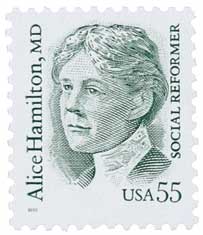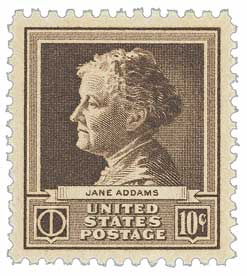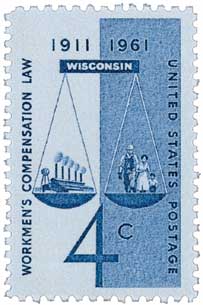
# 1186 - 1961 4c Workmen's Compensation Law
4¢ Workmen’s Compensation
City: Milwaukee, WI
Quantity: 121,015,000
Printed by: Bureau of Engraving and Printing
Printing Method: Rotary Press
Perforations: 10 1/2 x 11
Color: Ultramarine
First Workmen’s Compensation Law in 1911
Happy Birthday, Alice Hamilton

Doctor and research scientist Alice Hamilton was born on February 27, 1869, in Manhattan, New York. Hamilton was a pioneer in the fields of occupational health and industrial toxicology. Her extensive research and thorough reports helped improve working conditions across America.
Hamilton spent much of her childhood with family in Fort Wayne, Indiana. She and her siblings were homeschooled, though she did attend finishing school in Connecticut. Though Hamilton came from a wealthy family, she wanted to be of service to others. At one time she wanted to me a medical missionary, but was unsure she could do it, so she opted to become a doctor. She studied at Fort Wayne College of Medicine for a year before entering the University of Michigan Medical School in 1892.

Hamilton went on to do her internships in Minneapolis and Boston. During this time, she decided that she didn’t want to open a medical practice and returned to school to study bacteriology. Hamilton also became interested in public health. She then went to Germany in 1895 to study bacteriology and pathology there for a year. After completing her postgraduate studies at Johns Hopkins, Hamilton became a professor of pathology at the Woman’s Medical School of Northwestern University.

Shortly after her arrival in Chicago, Hamilton realized a long-time goal of becoming a member and resident of Jane Addams’s Hull House. After working days at the medical school, she spent her evenings working at the Hull House. While there, she became Addams’s personal physician, taught English and art, oversaw fencing and athletic programs, and ran a baby clinic. Hamilton eventually left Chicago but returned to Hull House for several months every year until Addams died in 1935.

Hamilton’s work at Hull House introduced her to many people who worked dangerous jobs that negatively affected their health. This inspired her to start studying occupational illnesses and injuries so that she might help improve their working conditions and overall health. In 1910, she was made the medical investigator of the Illinois Commission on Occupational Diseases. In that role she looked into industrial poisons such as lead. Her report helped inspire the first workers’ compensation laws in Illinois in 1911. These and similar laws pushed employers to take proper precautions to protect their employees.
Hamilton was eventually the nation’s leading authority on lead poisoning. She also spent a decade looking into other toxic disorders caused by a variety of substances including carbon monoxide, mercury, radium, and more. Hamilton is considered a pioneer in the fields of occupational epidemiology and industrial hygiene. Her reports helped introduce significant health reforms.
In 1919, Hamilton became the first woman appointed to the Harvard University faculty when she became an assistant professor at the new Department of Industrial Medicine (later the School of Public Health). She remained there until her retirement in 1935. During that period, she continued her research, published a number of influential reports for the Department of Labor, and wrote the first US textbook on industrial poisons.

After leaving Harvard, Hamilton worked as a medical consultant for the US Division of Labor Standards and president of the National Consumers League. Throughout her life she had also been an activist for social reform, peace, and women’s rights. She died on September 22, 1970.
4¢ Workmen’s Compensation
City: Milwaukee, WI
Quantity: 121,015,000
Printed by: Bureau of Engraving and Printing
Printing Method: Rotary Press
Perforations: 10 1/2 x 11
Color: Ultramarine
First Workmen’s Compensation Law in 1911
Happy Birthday, Alice Hamilton

Doctor and research scientist Alice Hamilton was born on February 27, 1869, in Manhattan, New York. Hamilton was a pioneer in the fields of occupational health and industrial toxicology. Her extensive research and thorough reports helped improve working conditions across America.
Hamilton spent much of her childhood with family in Fort Wayne, Indiana. She and her siblings were homeschooled, though she did attend finishing school in Connecticut. Though Hamilton came from a wealthy family, she wanted to be of service to others. At one time she wanted to me a medical missionary, but was unsure she could do it, so she opted to become a doctor. She studied at Fort Wayne College of Medicine for a year before entering the University of Michigan Medical School in 1892.

Hamilton went on to do her internships in Minneapolis and Boston. During this time, she decided that she didn’t want to open a medical practice and returned to school to study bacteriology. Hamilton also became interested in public health. She then went to Germany in 1895 to study bacteriology and pathology there for a year. After completing her postgraduate studies at Johns Hopkins, Hamilton became a professor of pathology at the Woman’s Medical School of Northwestern University.

Shortly after her arrival in Chicago, Hamilton realized a long-time goal of becoming a member and resident of Jane Addams’s Hull House. After working days at the medical school, she spent her evenings working at the Hull House. While there, she became Addams’s personal physician, taught English and art, oversaw fencing and athletic programs, and ran a baby clinic. Hamilton eventually left Chicago but returned to Hull House for several months every year until Addams died in 1935.

Hamilton’s work at Hull House introduced her to many people who worked dangerous jobs that negatively affected their health. This inspired her to start studying occupational illnesses and injuries so that she might help improve their working conditions and overall health. In 1910, she was made the medical investigator of the Illinois Commission on Occupational Diseases. In that role she looked into industrial poisons such as lead. Her report helped inspire the first workers’ compensation laws in Illinois in 1911. These and similar laws pushed employers to take proper precautions to protect their employees.
Hamilton was eventually the nation’s leading authority on lead poisoning. She also spent a decade looking into other toxic disorders caused by a variety of substances including carbon monoxide, mercury, radium, and more. Hamilton is considered a pioneer in the fields of occupational epidemiology and industrial hygiene. Her reports helped introduce significant health reforms.
In 1919, Hamilton became the first woman appointed to the Harvard University faculty when she became an assistant professor at the new Department of Industrial Medicine (later the School of Public Health). She remained there until her retirement in 1935. During that period, she continued her research, published a number of influential reports for the Department of Labor, and wrote the first US textbook on industrial poisons.

After leaving Harvard, Hamilton worked as a medical consultant for the US Division of Labor Standards and president of the National Consumers League. Throughout her life she had also been an activist for social reform, peace, and women’s rights. She died on September 22, 1970.











